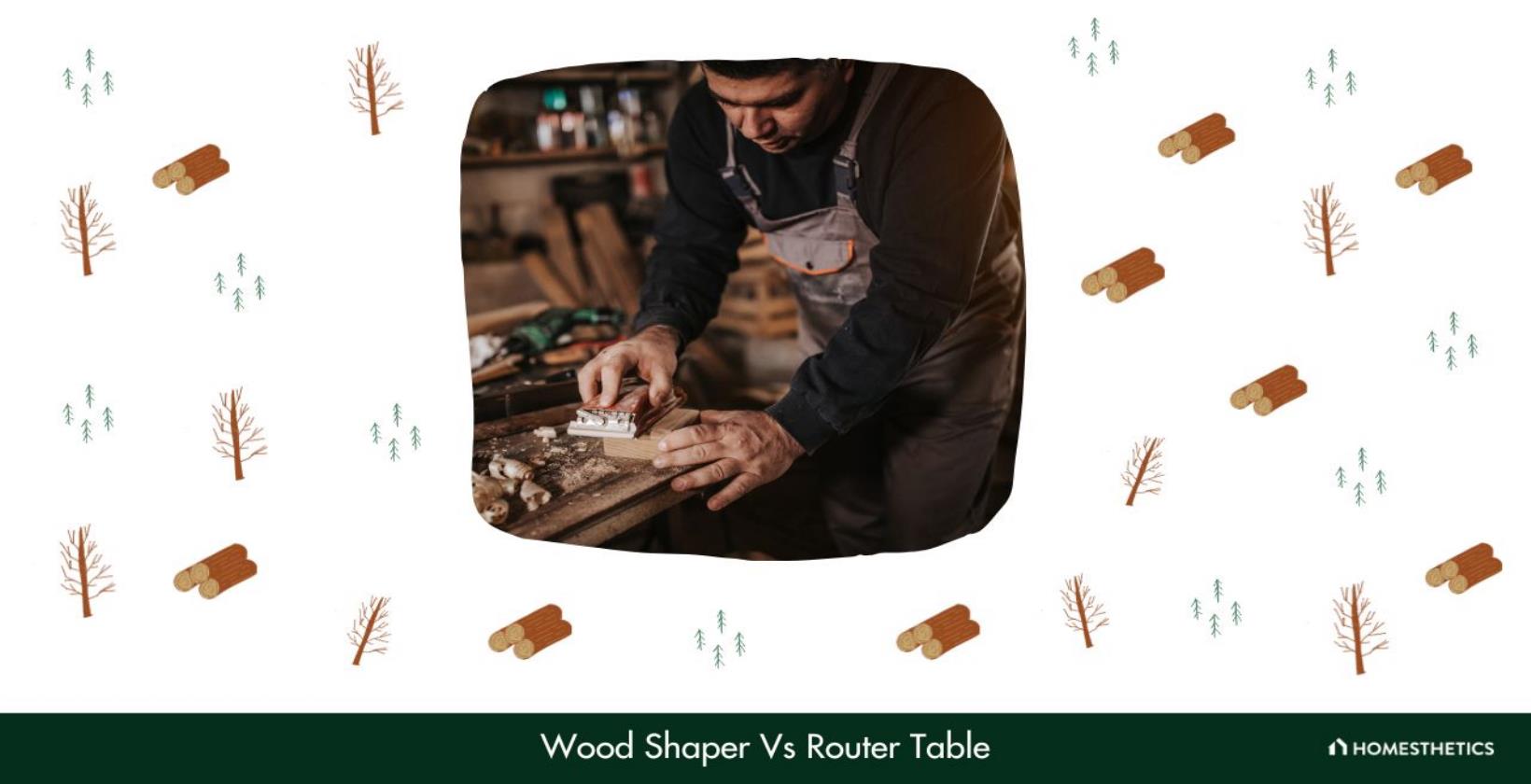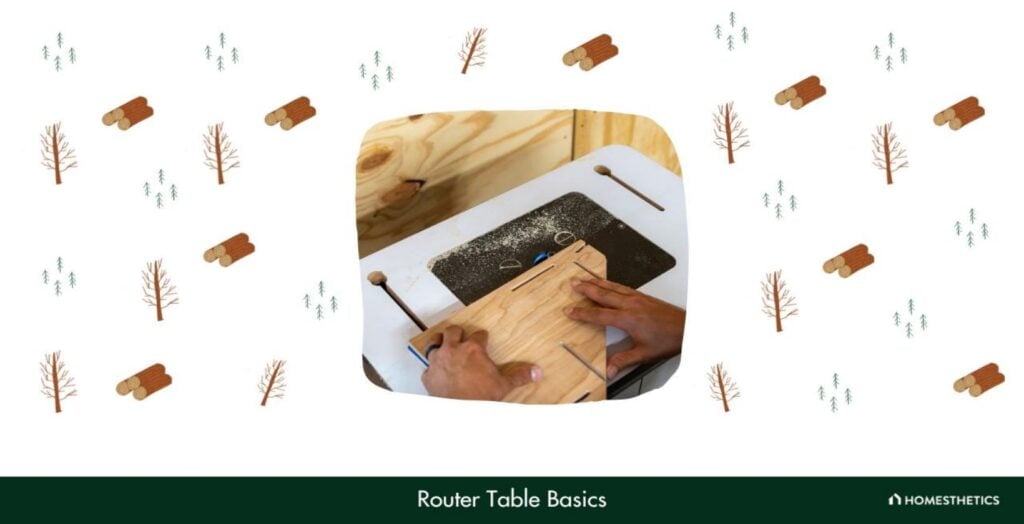Wood shapers and router tables are woodworking tools that shape and cut wood. Shapers are best for larger pieces and mass production, while router tables are good for small projects and versatility, both are essential for woodworking.

Wood shapers and router tables are machines essential for any woodworking shop. Whether you want to create a raised panel door or intricate molding, the right tool can make all the difference. This article will explore all the similarities and differences between these two tools, including cost, precision, speed, and much more.
Wood shaper basics

With its powerful motor, razor-sharp blades, and precise spindle, the wood shaper is truly the king of all woodworking tools. It is capable of transforming even the most unassuming piece of wood into a work of art.
Let’s take a closer look at some of the amazing features of the wood shaper.
First and foremost, we have the spindle - the heart of the machine. Whether you’re working with larger bits or smaller cutters, the spindle is available in various sizes so that you can choose the perfect one for your needs. With a wide speed range that can reach up to thousands of revolutions per minute, you can be sure that your wood will be cut with utmost precision.
Of course, the spindle wouldn’t be complete without the motor to drive it. That’s why they come with heavy-duty induction motors, capable of handling even the toughest woodworking jobs with ease. With more torque than a wood router, the wood shaper can cut through the thickest materials quickly and efficiently. Additionally, with a range of horsepower options available, you can choose just the right setting based on your needs.
Further, the wood shaper comes with other useful features, like the fence, which ensures that your workpiece stays in place and your cuts are precise. With a split fence that can be adjusted in multiple directions, you can work with the thickest grain directions.
Additionally, incorporating accessories like sliding tables and jigs allows even more precise cuts, while the dust collection system ensures that your workspace stays clean and safe.
Let’s not forget about the shaper cutter. With a range of options, including reversible shaper cutters, tile cutters, and raised panel cutters, you can easily create a variety of intricate designs. And my findings show that with the ability to make many cuts in one pass, you can save time and money on your woodworking projects.
So, how much does all of this incredible technology cost? Well, the total cost of wood shapers depends on various factors, such as the size of the machine and the number of features you choose.
But one thing’s certain - the wood shaper is a great tool for any serious woodworker. It may be more expensive than your average table saw or any other type of wood router, but it’s also more versatile and capable of performing many functions that these tools cannot.
Router table basics

Have you ever struggled with heavy-duty woodwork, sweating bullets while trying to make precise cuts on large pieces of wood with a handheld tool? Fear not, for the router table is here to save the day.
It consists of a tabletop, a spindle, and a motor. The spindle is the tool that holds the router bits, used to cut the wood material quickly and efficiently. And unlike a handheld router, the router keeps the wood stable while you work, making it easier to make precise cuts without worrying about vibration.
The tool comes in various sizes, and horse-powered motors to suit any need. Some router tables can even be paired with a spindle mount and a lifting system which can be paired with different router bits, allowing you to cut at tilting angles and add intricate details to your furniture. The speed range is also adjustable, making it possible to change the speed according to the material being used and the type of bit being employed.
Another great feather of the router is its fence, which can be adjusted to fit the size of the workpiece being cut. This feature helps to keep the wood in place and prevent the bit from wandering off track. Moreover, some router tables come equipped with a split fence that can be moved to either side of the bit to allow cuts in opposite directions.
The router table also can hold larger cutters than a handheld router. This means that it is possible to make a raised panel door and stile cuts in a single pass, saving you time and money. Some models even come with a power feeder that helps to move the wood through the cutter head automatically.
Dust collection is another important feature of the router table. This feature is especially helpful when working with smaller router bits, as the dust can quickly clog the cutter and hinder precision. Many tables come with a dust port that can be connected to a shop vacuum or a dust collector to help keep the workspace clean and free from sawdust.
Regarding the total cost of router tables, many options are available, ranging from simple tabletops to variable-speed router models with sliding tables and multiple functions. Regardless of the cost, this is an investment that will pay dividends through precise cuts and a smoother workflow.
Wood shaper vs router table compared

Now, we’ll explore the two wondrous machines in the woodworking arsenal, the wood shaper, and the router table, based on my first-hand experience. Both are mighty tools that shape and mold wood to our whims, but let’s compare them to know what makes them unique and necessary in their way.
1. Versatility
The router table can accomplish many functions with just one tool, making it a more versatile option. It can change the shape and size of wood according to your needs with its tilting spindle and wide range of spindle sizes.
However, the wood shaper is the most efficient tool for shaping larger pieces of wood with its large shaper cutters.
2. Speed
After spending time with the router table and the wood shaper, I have found that both spin their cutters at high speeds. Yet, the wood shaper can go even faster with a spindle reaching up to 10,000 revolutions per minute (RPM). This means it can cut through the wood quickly, making it perfect for heavy-duty work.
3. Precision
When it comes to precision, both machines can deliver, but the wood shaper takes the cake. Its heavier and larger motor provides more torque than router tables, making it better suited for working with harder woods. It can make a single pass on a larger workpiece, which saves time and effort compared to several passes on a router table.
4. Cost
The router table is more affordable than the wood shaper, making it perfect for hobbyists or those who want to save money. However, if you plan on creating large pieces of furniture, investing in a wood shaper may be a better long-term decision.
5. Dust collection
Both machines create a lot of sawdust, but the router table has an advantage with its split fence that allows for better dust extraction. This helps keep the workplace cleaner, especially when used with a shop vacuum.
However, a dust collection system can also be incorporated with the wood shaper, ensuring that your workspace stays hygienic and free of dust and dirt.
6. Fence
The router table has a universal fence that can be used with different sizes of bits, making it more versatile in terms of the type of cuts you can make. However, the wood shaper has a more heavy-duty fence that can handle larger workpieces and ensure that the wood doesn’t move during the cutting process.
7. Space
Regarding space, the router table is more compact and can fit smaller workshops or garages. The wood shaper takes up more space due to its sliding table and larger cutter head.
So, there you have it - the router table and the wood shaper, two great tools with similar functions but different specialties. Choose wisely according to your needs, budget, and space, among other factors. However, no matter what machine you choose, always pay attention to the grain direction, wear safety glasses follow the required safety rules, and have fun!
Shaper vs router table: What’s best for your workshop?
So, which is the true champion of the woodworking workshop? The answer lies not in one machine over the other but in the needs of the craftsperson. Drawing from experience, the router table is a versatile workhorse, capable of handling a wide variety of tasks with ease. And when it comes to shaping and profiling, the wood shaper is the king of the hill.
But why choose between the two when you can have the best of both worlds? The router table and the wood shaper can work together, each complementing the other’s strengths and weaknesses. With both of these machines at your fingertips, there’s no limit to what you can create.
So, will you choose the versatility of the router table or the raw power of the wood shaper? Or will you embrace them both and take your woodworking to new heights? The answer is up to you. But one thing is certain - anything is possible with either machine in your workshop.
Can a router table be used as a wood shaper?
A router table cannot be used as a wood shaper despite having similar functions as they are distinct tools. A router table utilizes a handheld router mounted upside down, whereas a wood shaper has a spindle cutter. Although some tasks may overlap, they are not interchangeable due to their structural differences.
Is it possible to create a raised panel door using router tables?
Yes, it is possible to create a raised panel door using router tables with the appropriate router bits and a router table fence.
What safety precautions should beginners take when using router tables and wood sharpers?
A few safety precautions beginners should take when using router tables and wood sharpers are:
- Always wearing safety goggles
- Using push blocks or feather boards
- Securing workpieces firmly
Remember to start with small cuts for better control and reduced kickback risks.
The debate between the wood shaper and a router tabletop is a thrilling contest of precision accessibility, and efficiency.
Wood shapers, with their powerful motors and adaptable spindles, excel at handling large workpieces and creating intricate profiles on wood. On the other hand, router tables offer the advantage of affordability and portability, making them ideal for small-scale operations and hobbyists.
Wood shapers embody raw power and precision, while router tables showcase flexibility and accessibility. Weighing these factors against individual needs will ensure a tailored decision for optimal woodworking outcomes.
In the end, the wood shaper and the router table have their unique advantages and disadvantages. As such, the final choice should be yours based on your woodworking requirements.
And that brings me to the end of this guide!
